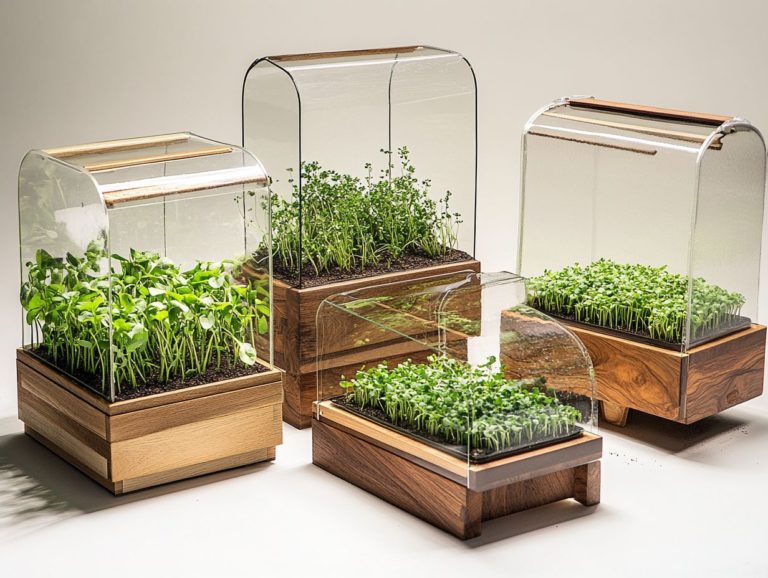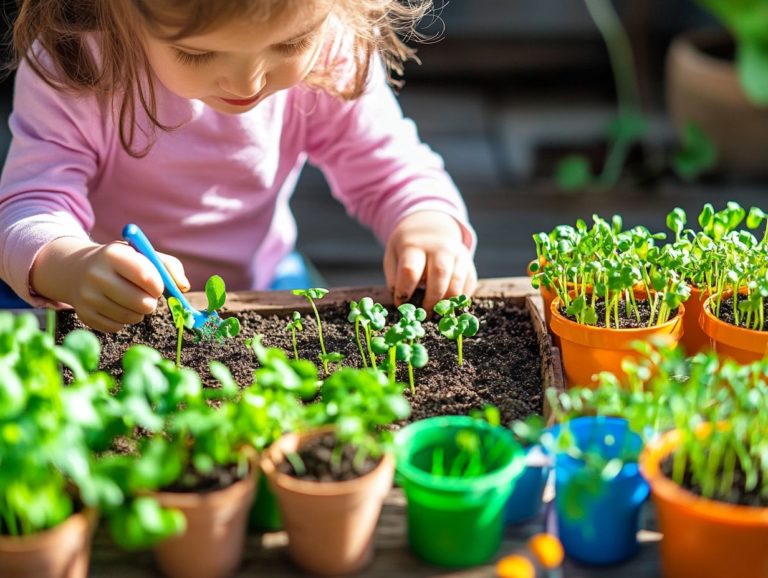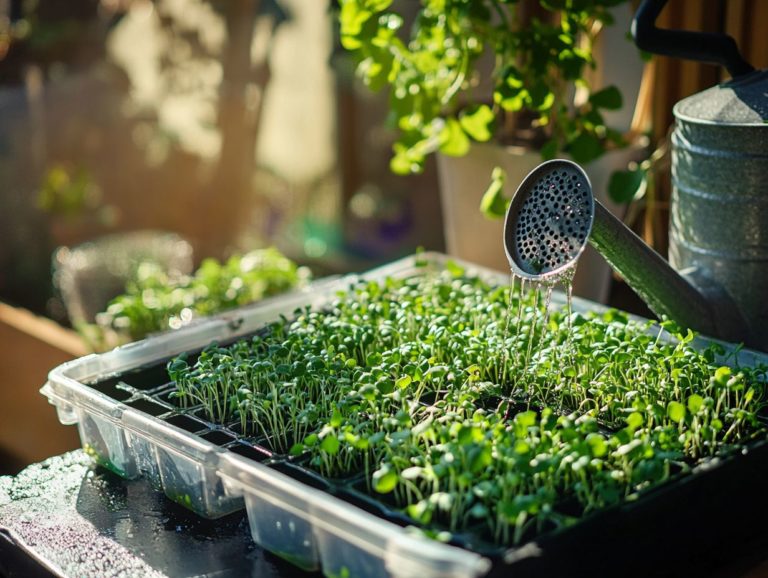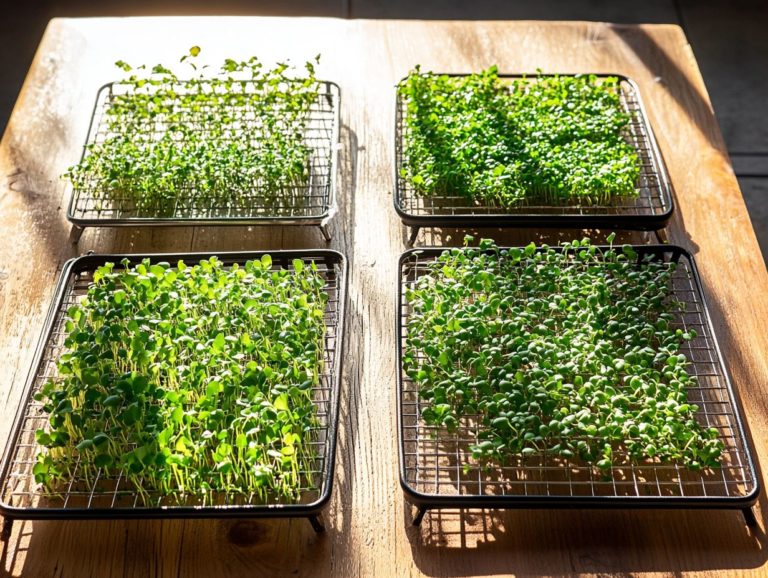How to Maintain Your Microgreen Equipment
Microgreens aren t merely a trendy garnish for your dishes; they deliver an impressive burst of flavor and a wealth of nutrients.
By growing your own microgreens, you can enjoy substantial cost savings and guarantee that fresh, organic produce is always within reach.
This guide will walk you through the essentials of cultivating microgreens. It details the necessary equipment, maintenance tips, and strategies to maximize their lifespan.
Whether you re an experienced gardener or just starting out, you ll discover valuable insights to enrich your growing journey.
Contents
- Key Takeaways:
- Benefits of Growing Your Own Microgreens
- Essential Equipment for Growing Microgreens
- Maintaining Your Microgreen Equipment
- Tips for Maximizing Equipment Lifespan
- Frequently Asked Questions
- What are the essential steps to maintain my microgreen equipment?
- How often should I clean and disinfect my microgreen equipment?
- What should I use to clean and disinfect my microgreen equipment?
- What should I do if I notice any damage or wear and tear on my microgreen equipment?
- How should I store my microgreen equipment when not in use?
- Do I need to maintain my microgreen equipment if I am using it for personal use?
Key Takeaways:
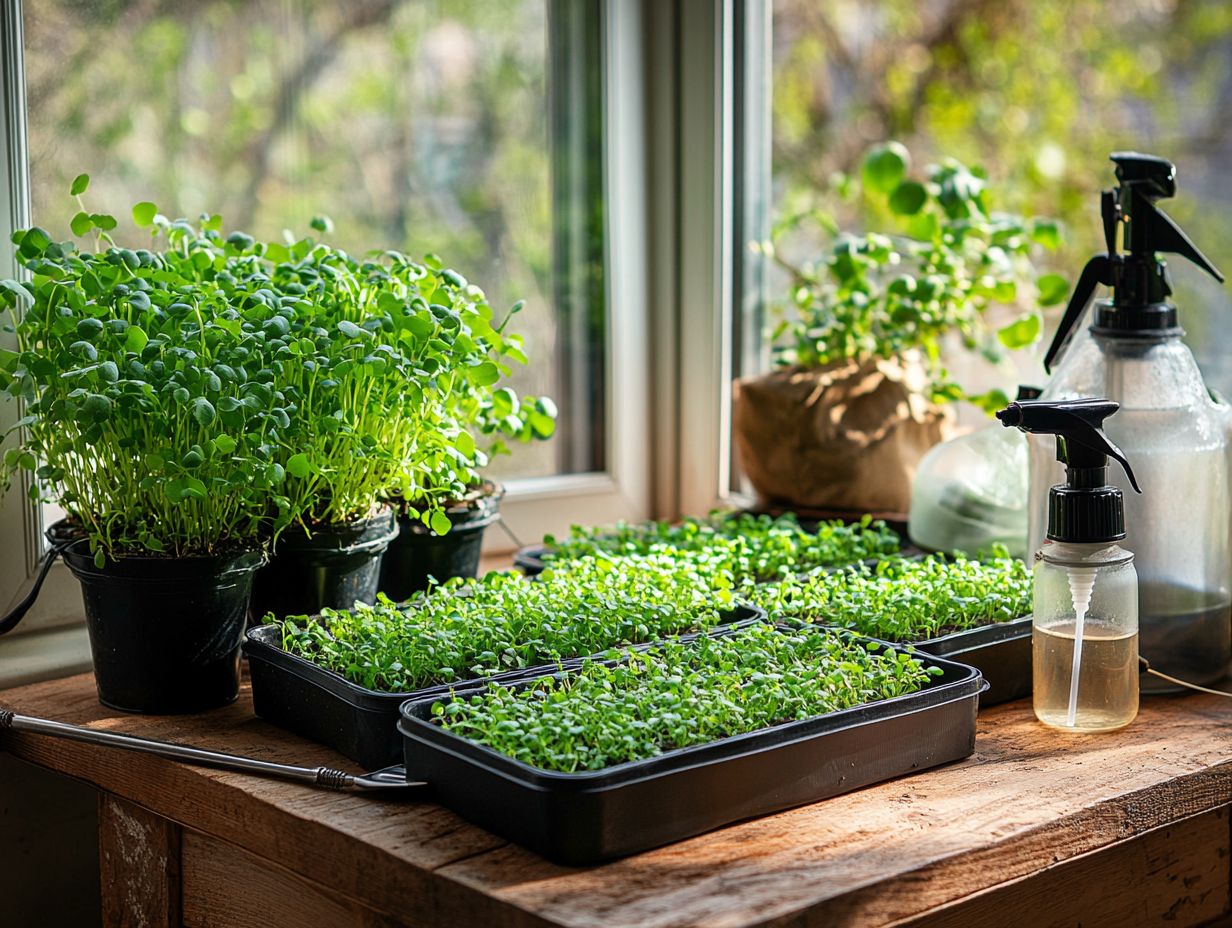
- Clean and sanitize your microgreen equipment regularly. This practice prevents contamination and ensures optimal growth.
- Replacing worn or damaged parts and troubleshooting issues promptly can extend the lifespan of your microgreen equipment.
- Proper storage and usage techniques, such as avoiding harsh chemicals, can help maximize the longevity of your microgreen equipment.
What are Microgreens?
Microgreens are young, edible plants that you can harvest at an early growth stage. They deliver a vibrant burst of flavor and are a nutrient-rich addition to your dishes. Unlike their mature counterparts, microgreens like Broccoli, Kale, and Peas are brimming with vitamins and minerals such as Vitamins A, C, K, and E.
This makes them an appealing choice for health-conscious individuals eager to elevate home gardening and food production efforts.
Their ease of growth indoors, combined with the availability of organic seeds, means these tiny greens can easily become a staple in your home garden. They are perfect for boosting nutrition in your smoothies and Buddha Bowls.
To create optimal growing conditions for microgreens, ensure they receive bright, indirect sunlight and are planted in well-draining soil. This setup allows them to thrive indoors, no matter the season.
You ll find a variety of seeds, such as Radish, Sunflower, and Arugula, ready for cultivation each bringing its unique flavor profile and visual appeal to your dishes.
Both chefs and home cooks appreciate the versatility of these miniature plants. They not only enhance the aesthetic of your plates but also act as a concentrated source of nutrients.
Imagine having fresh microgreens at your fingertips! Embracing this growing trend aligns with a broader movement toward sustainable food production, giving you the power to conveniently cultivate your own nutrient-rich greens right at home.
Benefits of Growing Your Own Microgreens
Growing your own microgreens offers impressive benefits. They elevate your vegetable intake and provide substantial health advantages that contribute to a nutritious diet.
By cultivating these small yet powerful plants, you can refine your indoor gardening skills and learn effective techniques like soaking seeds to improve the germination process. You can also save a significant amount of money after all, they often cost more to buy than to grow yourself.
Not only do microgreens provide a wealth of antioxidants, vitamins, and minerals, but they also grant you the pleasure of fresh flavors throughout the year. This enhances the enjoyment of smoothies and Buddha Bowls, transforming your gardening experience into a delightful and rewarding pursuit.
Nutritional Value and Cost Savings
Microgreens offer remarkable nutritional value. They can have up to 40 times more vitamins and minerals than mature plants, delivering essential nutrients like Vitamins A, C, and K along with abundant antioxidants all at a fraction of the cost.
With the trend toward healthy eating, growing microgreens at home enhances your well-being and allows you to harvest them fresh from your garden. This not only promotes better health but also provides significant savings on your grocery bill.
These tiny powerhouses, including kale, radish, and broccoli, are bursting with flavor and provide a concentrated dose of nutrients. For instance, kale microgreens are rich in Vitamins A, C, and K, while radish microgreens deliver a robust punch of vitamins C and E. The antioxidants in these greens help fight harmful substances in your body that can cause damage, supporting your overall health.
Unlike those overpriced and often less than fresh store-bought options, cultivating microgreens at home allows you to enjoy their high nutritional value while significantly reducing your grocery expenses. To get started, consider investing in the must-have equipment for microgreen cultivation. This approach makes healthy living accessible and incredibly economical!
Essential Equipment for Growing Microgreens
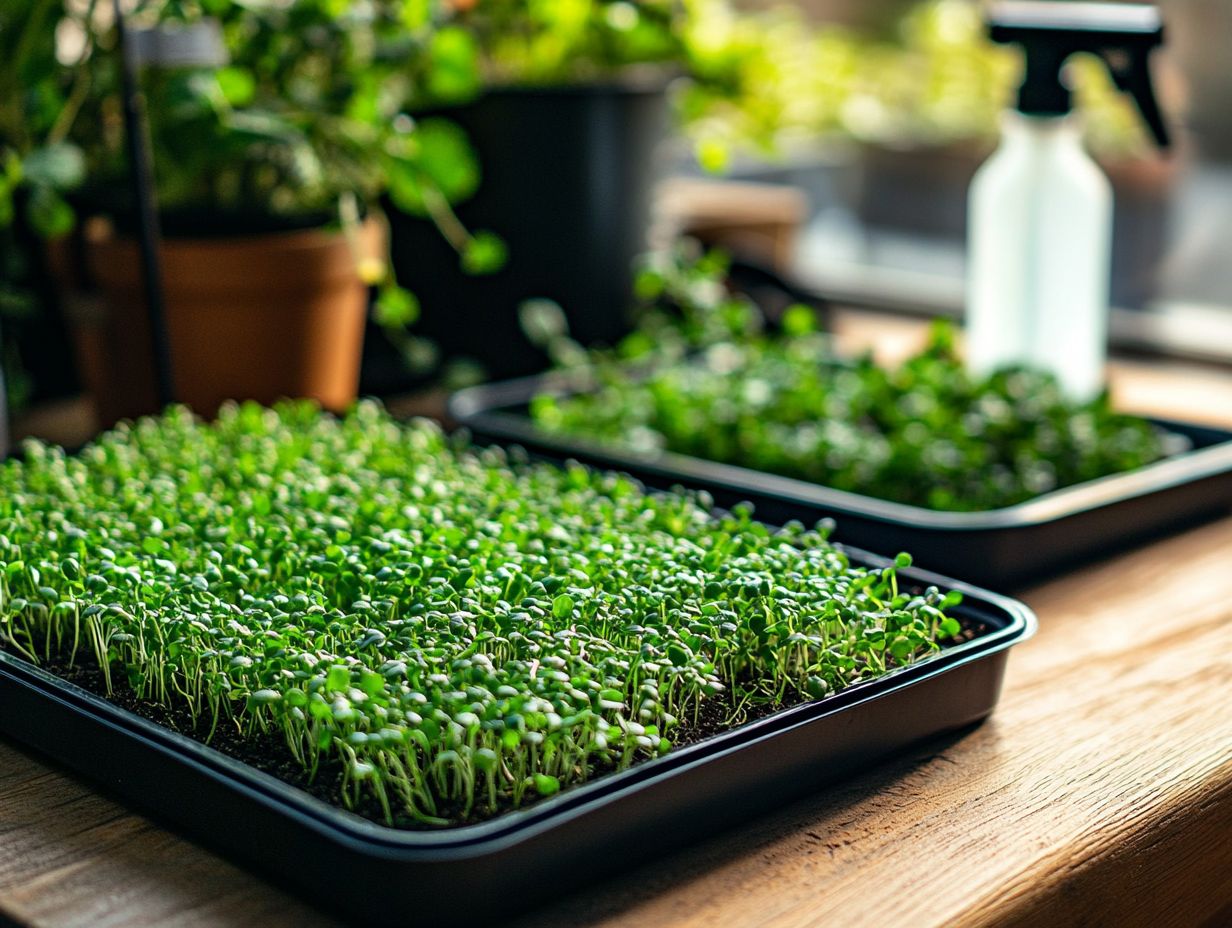
To successfully cultivate microgreens, you need the right equipment. This includes seed trays, suitable growing mediums like coconut coir or peat moss, and high-quality organic seeds that promote optimal growth.
A proper setup ensures your microgreens receive the necessary light and moisture, both crucial for germination and overall plant health. Additionally, knowing how to prevent spoilage in microgreens is essential for maintaining their freshness. Investing in these key tools enables you to create a thriving indoor garden that elevates your culinary repertoire and contributes to sustainable food production.
Overview of Necessary Tools
When starting your microgreen garden journey, you ll need a few essential tools: seed trays, a suitable growing medium, and organic seeds. These are crucial for ensuring your plants grow optimally and thrive in a healthy environment.
Mastering proper watering techniques is vital to prevent over-saturation or drought, both of which can hinder germination and lower your yield, especially during this crucial phase.
To cultivate a flourishing microgreen environment, selecting high-quality organic seeds is non-negotiable. They provide essential nutrients and robust flavors that elevate your harvest. Seed trays create a structured space for growth, making management and light access easier, while a nutrient-rich growing medium supports vigorous root development and moisture retention. For optimal results, consider storing microgreens properly to maintain their freshness.
Regularly monitoring moisture levels is critical for nurturing those delicate sprouts. The way you water your microgreens can be the defining factor between a bountiful harvest and a lackluster crop. Once you’ve enjoyed your harvest, it’s essential to know what to do with microgreens after harvest. By understanding how these elements interact, you’ll be well on your way to cultivating a healthy and productive microgreen garden.
Maintaining Your Microgreen Equipment
Maintaining your microgreen equipment is essential for achieving a successful harvest. This involves regular cleaning and sanitizing techniques designed to prevent diseases and pests that could jeopardize your indoor gardening efforts.
By taking proper care of tools such as seed trays and growing mediums, you extend their lifespan and enhance the growing environment for your microgreens. Additionally, understanding microgreen post-harvest care is essential. This attention to detail safeguards your investment in this gratifying hobby, ensuring that you enjoy bountiful results.
Cleaning and Sanitizing Techniques
Ready to boost your microgreens? Effective cleaning and sanitizing techniques are key for preventing pests and diseases from encroaching on your microgreen crops. This ensures your equipment stays in prime condition for future plantings.
By regularly disinfecting seed trays and other tools, you foster a healthier growing environment and enhance the overall success of your indoor gardening experience.
Adopting a systematic approach to equipment maintenance allows you to effectively protect your microgreens from harmful factors. For example, after each use, rinsing your seed trays with warm, soapy water will help eliminate soil and organic residues. Follow this up by soaking them in a bleach mixed with water or a strong cleaning solution available for purchase to eliminate any lingering pathogens. Additionally, consider learning how to use hydroponics for microgreens to enhance your growing methods.
When it comes to tools like scissors and trowels, a quick wipe down with alcohol or sanitizing them with heat ensures they are free from any contaminating agents. Establishing an organized cleaning schedule will keep pests and diseases at bay, ultimately enhancing your microgreen yield and cultivating a thriving indoor garden. For more insights, check out the importance of cleanliness in microgreen harvesting.
Replacing Parts and Troubleshooting
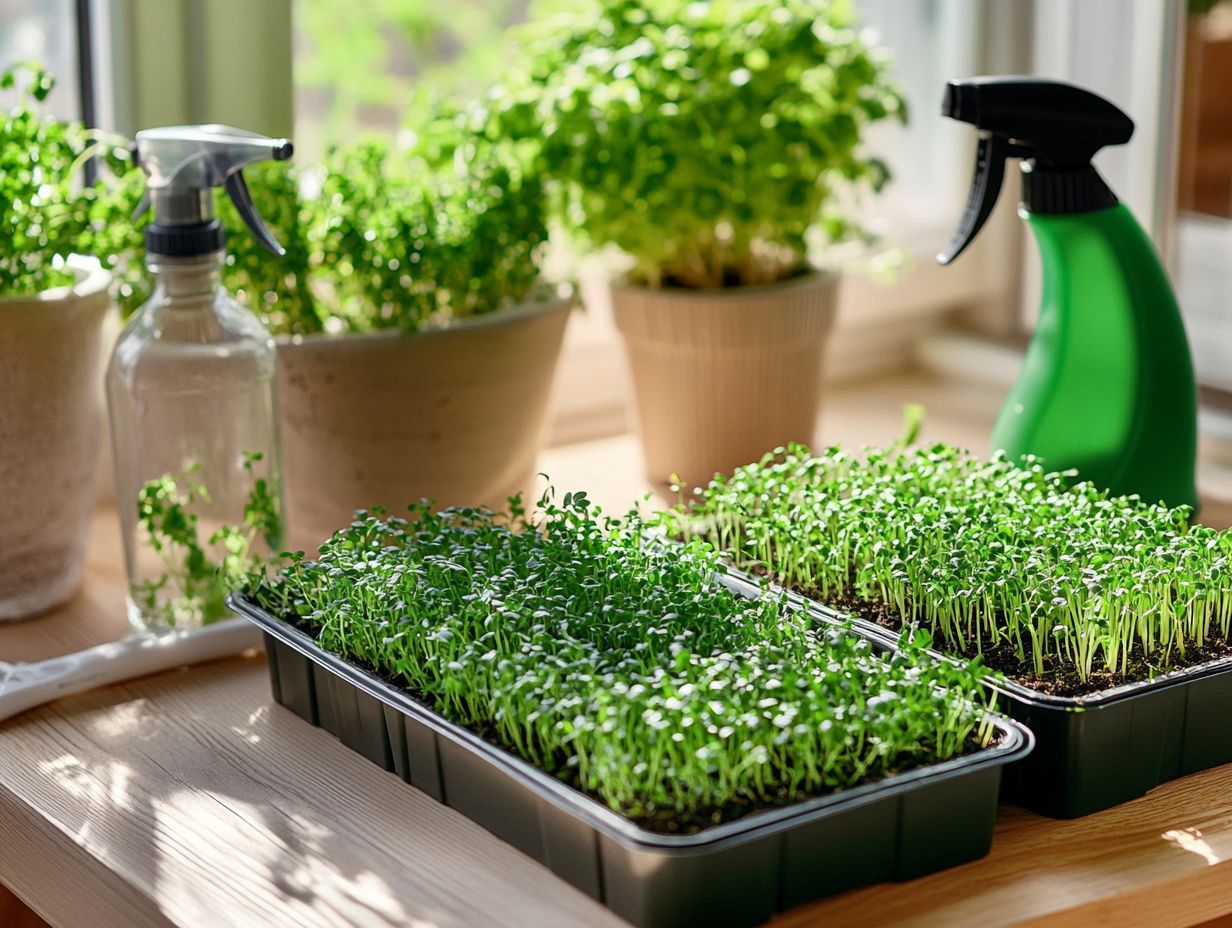
Being proactive in replacing worn-out parts of your microgreen equipment is essential for maintaining optimal plant growth and sidestepping potential setbacks in your gardening journey. By troubleshooting common issues whether they re related to seed trays or growing mediums you can quickly adapt and continue nurturing your microgreens without significant interruptions.
Inspect vital components like lights and watering systems regularly to catch problems early, ultimately fostering a healthier growing environment. Keep an eye out for signs of wear, such as rust on metal trays or cracks in plastic containers. These can negatively impact the germination and growth rates of your delicate microgreens. For more detailed information, check out this guide on how to use a grow tent for microgreens.
Understanding the typical symptoms of common issues like slow growth or mold development gives you the power to take corrective actions swiftly. It’s equally important to invest in quality equipment that offers durability, maximizing your chances of a successful harvest. Additionally, learning storing microgreens: tips for first-time growers can ensure that your gardening experience remains rewarding.
Tips for Maximizing Equipment Lifespan
To maximize the lifespan of your microgreen gardening equipment, it s essential to adopt proper storage techniques and recommended methods for using your tools. This ensures that your investment continues to deliver value over time.
By being intentional about how you handle and store your tools, you ll create a more efficient indoor gardening experience, fostering sustainable and productive growth cycles.
Proper Storage and Usage
Properly storing and using your microgreen equipment, like seed trays and growing mediums, is crucial for maintaining their effectiveness and longevity in your indoor gardening journey. Keep your tools in a clean, dry environment and use them according to established guidelines. This will significantly reduce wear and tear, allowing you to savor fresh microgreens for a longer time.
To enhance performance, consider organizing your equipment into dedicated storage bins or racks. Keep your seeds labeled and moisture-free. This level of organization not only prevents mixing varieties but also streamlines the planting process immensely.
It’s important to regularly check your growing mediums, ensuring they re stored in tightly sealed containers to maintain optimal moisture levels and avoid contamination.
When using these tools, adhering to recommended practices like pre-soaking seeds or rotating trays can boost germination rates and lower the risk of disease. By embracing these strategic practices, you can cultivate a more productive environment, ultimately leading to higher yields and healthier microgreens.
Final Thoughts and Recommendations
Proper care for your microgreen equipment is crucial. It helps you enjoy the tasty and healthy benefits of your indoor garden to the fullest.
Follow effective methods for storage, cleaning, and usage. This will help you grow a thriving microgreen garden that produces fresh greens all year.
Clean your trays and tools thoroughly between crops. This prevents pests and diseases, keeping your plants healthy.
Use high-quality soil and seeds to boost your results. A consistent watering schedule and proper light monitoring can greatly improve your yields.
Maximize your harvest by trying different types of microgreens. Each offers unique flavors and health benefits, enriching your indoor garden.
Frequently Asked Questions

What are the essential steps to maintain my microgreen equipment?
To maintain your microgreen equipment, regularly clean and disinfect all surfaces, check for any damage, and store it properly after each use.
How often should I clean and disinfect my microgreen equipment?
Be sure to clean your microgreen equipment after each use! This prevents harmful bacteria and keeps everything working well.
What should I use to clean and disinfect my microgreen equipment?
Mild dish soap and water can clean most surfaces. For disinfecting, use a mixture of water and vinegar or a food-safe disinfectant spray.
What should I do if I notice any damage or wear and tear on my microgreen equipment?
If you notice any damage, address it immediately. Depending on the severity, you may need to repair or replace the equipment to ensure safe and effective use.
How should I store my microgreen equipment when not in use?
Store your microgreen equipment in a cool, dry place away from direct sunlight. Clean and dry it thoroughly before storing to prevent bacteria growth.
Do I need to maintain my microgreen equipment if I am using it for personal use?
Yes! It s important to maintain your equipment even for personal use. Regular maintenance ensures longevity and promotes a safe environment for growing microgreens.
Ready to grow your microgreens? Happy gardening!

